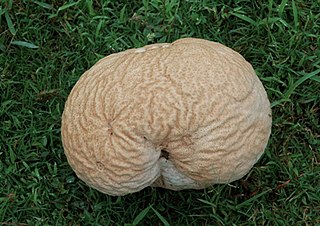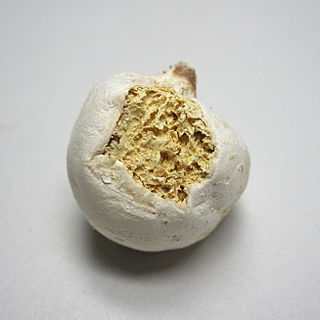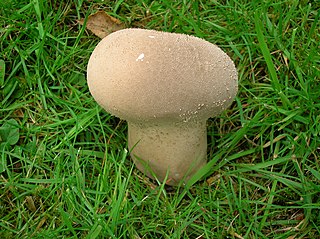Related Research Articles

Coprinus is a small genus of mushroom-forming fungi consisting of Coprinus comatus - the shaggy ink cap (British) or shaggy mane (American) - and several of its close relatives. Until 2001, Coprinus was a large genus consisting of all agaric species in which the lamellae autodigested to release their spores. The black ink-like liquid this creates gave these species their common name "ink cap" (British) or "inky cap" (American).

Calvatia is a genus of puffball mushrooms that includes the spectacular giant puffball C. gigantea. It was formerly classified within the now-obsolete order Lycoperdales, which, following a restructuring of fungal taxonomy brought about by molecular phylogeny, has been split; the puffballs, Calvatia spp. are now placed in the family Agaricaceae of the order Agaricales.

Leucocoprinus is a genus of fungi in the family Agaricaceae. Its best-known member is the yellow pot-plant mushroom, found worldwide. The type species is Leucocoprinus cepistipes. The genus has a widespread distribution and contains about 40 species. It includes some highly derived cultivars grown by the Acromyrmex and Atta leaf-cutting ants in an evolved ant–fungus mutualism.

Bovista is a genus of fungi commonly known as the true puffballs. It was formerly classified within the now-obsolete order Lycoperdales, which, following a restructuring of fungal taxonomy brought about by molecular phylogeny, has been split; the species of Bovista are now placed in the family Agaricaceae of the order Agaricales. Bovista species have a collectively widespread distribution, and are found largely in temperate regions of the world. Various species have historically been used in homeopathic preparations.

Nidularia is a genus of nine species of fungi in the family Agaricaceae. Their fruit bodies resemble tiny egg-filled bird nests. The name comes from the Latin nidus meaning nest. The related genus Mycocalia was segregated from Nidularia in 1961 based on differences in the microscopic structure of the peridium.

Handkea is a genus of puffball mushrooms in the family Agaricaceae. In 1989, German mycologist Hanns Kreisel described the genus Handkea to include species of Calvatia with distinct microscopic features, including a unique type of capillitium, with curvy slits instead of the usual pores. Although accepted by some authors, the genus concept has been rejected by others.

Battarrea is a genus of mushroom-producing fungi. The genus used to be classified in the family Tulostomaceae until molecular phylogenetics revealed its affinity to the Agaricaceae. Species of Battarrea have a peridium that rests atop an elongated, hollow stipe with a surface that tends to become torn into fibrous scales. Inside the peridium, the gleba consists of spherical, warted spores, and a capillitium of simple or branched hyphal threads that have spiral or angular thickenings. The genus is named after Italian priest and naturalist Giovanni Antonio Battarra.

Arachnion is a genus of gasteroid fungi in the family Agaricaceae.
Attamyces is a fungal genus in the family Agaricaceae. This is a monotypic genus, containing the single species Attamyces bromatificus. The fungus was found fruiting on the nest of the fungus-growing ants Atta insularis in Cuba. Both the species and genus were described by German mycologist Hanns Kreisel in 1972. The specific epithet bromatificus refers to bromatia, which are swollen tips on the hyphae that the ants use as food.

Calbovista is a fungal genus containing the single species Calbovista subsculpta, commonly known as the sculptured puffball, sculptured giant puffball, and warted giant puffball. It is a common puffball of the Rocky Mountains and Pacific Coast ranges of western North America. The puffball is more or less round with a diameter of up to 15 cm (6 in), white becoming brownish in age, and covered with shallow pyramid-shaped plates or scales. It fruits singly or in groups along roads and in open woods at high elevations, from summer to autumn.

Disciseda is a genus of gasteroid fungi in the family Agaricaceae. It is a widely distributed genus that is prevalent in arid zones. Disciseda was circumscribed by mycologist Vassiliĭ Matveievitch Czernajew in 1845.

Holocotylon is a genus of fungi in the family Agaricaceae. It was circumscribed by American mycologist Curtis Gates Lloyd in 1906 with H. brandegeeanum as the type species.

Lycogalopsis is a genus of puffball fungi in the family Agaricaceae. It was circumscribed by mycologist Eduard Fischer in 1886, with L. solmsii as the type species.
Metraria is a genus of two species of fungi in the family Agaricaceae.

Montagnea is a genus of fungi in the family Agaricaceae. The genus has a widespread distribution in subtropical dry areas, and contains five species. Montagnea was circumscribed by Swedish mycologist Elias Magnus Fries in 1836.
Secotium is a genus of fungi in the family Agaricaceae. The members of this genus are closely related to ordinary Agaricus mushrooms, but do not open out in the usual way; this has given rise to the term "secotioid" for such mushrooms in general. They are thought to form an evolutionary link between agarics and gasteroid fungi. Secotium is a widespread genus, with species that are predominantly found in warm and arid regions.
Andrew Price Morgan was an American debater. He investigated the flora of the Miami Valley in Ohio. While his interest included flowering plants, as noted by his Flora of the Miami Valley, Ohio, his special interest was in fungi. Morgan worked as a teacher in Dayton. He studied the botany of the Great Miami River, publishing in 1878 the Flora of the Miami River, Ohio; Morgan also showed particular interest in mycology and bryology. A.P. Morgan was a mentor to the prominent American mycologist Curtis Gates Lloyd. His correspondence with Lloyd is stored in the Lloyd Library and Museum in Cincinnati. Lloyds portion of the correspondence is stored in the Ada Hayden Herbarium at Iowa state university. Morgans collection of preserved fungi can also be found at the Ada Hayden Herbarium along with Laura Morgans gouache illustrations of fungi that could not be preserved.

Handkea excipuliformis, commonly known as the pestle puffball or long-stemmed puffball, is a species of the family Agaricaceae. A rather large puffball, it may reach dimensions of up to 15 cm (5.9 in) broad by 25 cm (9.8 in) tall. Widespread in northern temperate zones, it is found frequently on pastures and sandy heaths.

Vascellum is a genus of puffball fungi in the family Agaricaceae. The genus was defined by Czech mycologist František Šmarda in 1958.
References
- ↑ "Bovistella Morgan". MycoBank. International Mycological Association. Retrieved 2016-01-09.
- ↑ Morgan AP. (1892). "North American Fungi. Fifth Paper". Journal of the Cincinnati Society of Natural History. 14 (3–4): 141–148.
- ↑ Kirk PM. "Species Fungorum (version 23rd December 2015). In: Species 2000 & ITIS Catalogue of Life" . Retrieved 2016-01-09.